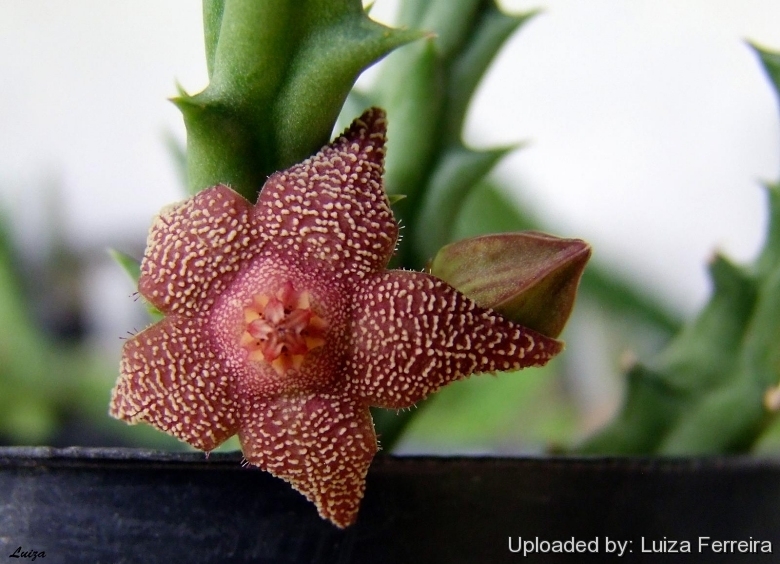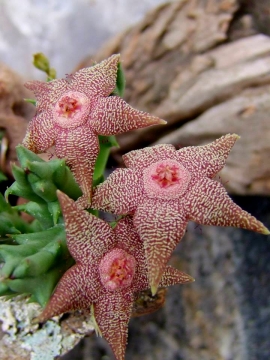




Your support is critical to our success.
Fl. Pl. South Africa 1933, xiii. sub t. 520.
Family: ASCLEPIADACEAE
Accepted Scientific Name: Orbea cooperi (N.E.Br.) L.C.Leach
Kirkia 10: 291 1975

Origin and Habitat: South Africa ( The areal of Orbea cooperi is southern to that of the closely related Orbea tapscottii and is widespread in the Eastern Cape, extending northwestwards through the western Free State into the Northern Cape).
Synonyms:
- Orbea cooperi (N.E.Br.) L.C.Leach
- Stapelia cooperi N.E.Br.
- Stapeliopsis cooperi (N.E.Br.) E.Phillips
- Stultitia cooperi (N.E.Br.) E.Phillips
ENGLISH: Carrion flower
AFRIKAANS (Afrikaans): Aasblom, Bokhoring
Description: Orbea cooperi formerly described in the genus Stultitia, is a succulent, leafless perennial forming small clumps or mats. The stems of O. cooperi are very similar to those of Orbea variegataSN|30532]]SN|19768]] or Orbea verrucosaSN|19768]]SN|30532]], but the flowers are rather different. In O. cooperi one to three flowers arise from the sessile inflorescence near the base of the stems and the flower is usually not more than 3.5 cm across and flattish, with a deep reddish colour and a lighter, slightly raised, cushion-like annulus, which forms the sides of a small corolla tube. This tube is short and only contains the base of the gynostegium. The outer corona lobes rise and spread to rest on its mouth. O. cooperi is closely related whit Orbea tapscottii.
Stems: Short and stumpy, erect or ascending, 3.5-5(-10) cm high, 8-10 mm thick excluding the teeth. Ribs obtuse, with spreading narrowly conical, very acute teeth 5-6 mm long with 2 minute teeth on each side at their middle, glabrous, green or greyish-green with chocolate-coloured or dark green spots and lines.
Flowers: Gradually developed 1–3 at a time up to 10 or more from a sessile cyme or cluster at the base of the stems. Pedicels 6-12 mm long, glabrous. Sepals 4-5 mm long, ovate or ovate-lanceolate, acuminate, glabrous. Corolla 30-40 mm in diameter, flat to somewhat reflexed, with stellately spreading or recurving lobes and an annulus on the disk, glabrous, smooth and “olive colour with dashes or longitudinal streaks of purple” (Pillans) on the back, rugose on the inner surface with minute crowded tubercles and short transverse ridges on the lobes and crowded minute tubercles on the annulus or lower part of it, ciliate on the basal half of the lobes with vibratile clavate purple hairs, otherwise glabrous, “light purple, with all the rugosities coloured yellow” (Pillans), “dull yellow, with fine purple-brown lines” and the annulus “purplish-pink” (Marloth). Lobes 10-14 mm long, 9-10 mm broad, ovate, acute, somewhat convex from the slightly recurving margins. Annulus 8-9 mm across pentagonal, solid, cushion-like, with sloping sides and a central depression containing the corona, outer corona resting upon the cup of the annulus, somewhat saucer-like and subequally 10-toothed or with 5 short bifid or emarginate lobes 1 mm long and 1.5 mm broad, with obtuse or subacute deltoid teeth having a broadly triangular notch between them, “rich purple” (Pillans), “deep maroon” (Marloth), inner corona-lobes 2.5-3 mm long, with their basal part ascendingly incumbent on the backs of the anthers and dorsally connected to the outer corona by a stout basal projection, broadly ovate, oblong or ovate-oblong, entire or with 1–2 teeth on each side, apical part filiform or subulate, connivent-erect or with recurving and sometimes slightly clavate tips, pale yellow, minutely speckled with purple. The dense ring of hairs found in the base of the corolla tube in some species, such as O. variegata, is missing entirely in O. cooperi, though traces of these hairs remain in this area in the form of a dark patch with somewhat raised epidermal cells.
Fruits (follicles): Slightly diverging, about 9 cm long and 8 mm thick, fusiform, acute, glabrous, smooth, densely streaked with dark purple-brown on a pale ground colour.
Bibliography: Major references and further lectures
1) N. E. Brown “Flora Capensis”, Vol 4, page 518, (ì1909
2) Court, “Succulent flora of southern Africa”, A.A. Balkema, Rotterdam 141 (1981)
3) John Hunter Thomas “Systematic Botany Monographs” American Society of Plant Taxonomists, 2002
4) James Cullen, Sabina G. Knees, H. Suzanne Cubey “The European Garden Flora Flowering Plants: A Manual for the Identification of Plants Cultivated in Europe, Both Out-of-Doors and Under Glass” Cambridge University Press, 11 August 2011
5) White & Sloane, "The Stapelieae", edn 2, 1: f. 335-7, 339 (1937)
6) Foden, W. & Potter, L. 2005. “Orbea cooperi (N.E.Br.) L.C.Leach.” National Assessment: Red List of South African Plants version 2014.1. Accessed on 2015/02/15
7) “Orbea cooperi” in: Excelsa Taxonomic Series 1: 29 (1978).
8) “Orbea cooperi” in: “Flowering plants of South Africa: A Magazine Containing Hand-coloured Figures with Descriptions of the Flowering Plants Indigenous to South Africa. London, Johannesburg and Cape Town”, 12: 445 (1932)
9) Albers, F. & Meve, U. “Illustrated handbook of succulent plants . Asclepiadaceae.” Springer Verlag, Berlin .2002.
10) Barkhuizen, B.P. “Succulents of southern Africa with special reference to the succulent families found in the Republic of South Africa and South West Africa.” Prunell. Cape Town .1978.
11) Bruyns, P.V. “Monograph of Orbea and Ballyanthus (Apocynaceae-Asclepiadoidiae-Ceropegieae).” Systematic Botany Monographs 63: 1-195.2002.
12) Bruyns, P.V. “Stapeliads of southern Africa and Madagascar” vol. 1. Umdaus Press, Hatfield, Pretoria .2005.
13) Smith , C.A. “Common names of South African plants.” Memoirs of the Botanical Survey of South Africa No. 35.1966.

Stultitia cooperi (Orbea cooperi) Photo by: Luiza Ferreira
The gallery now contains thousands of pictures, however it is possible to do even more. We are, of course, seeking photos of species not yet shown in the gallery but not only that, we are also looking for better pictures than those already present. Read More...
Cultivation and Propagation: Orbea cooperiSN|30528]]SN|30528]] is an easy blooming plant when mature that require moderately watering through the growing season but enjoy plenty of water and some fertiliser in hot weather, this helps them to flower freely. Water more sparingly in winter according to temperatures. But, as with most asclepiads, it is unwise to leave them wet in cold weather. Winter care presents no problems at 5°C with plenty of light. Since roots are quite shallow, use a cactus mix or add extra perlite or pumice to regular soil potting soil. A gritty, very free-draining compost is suitable, and clay pots help the plants to dry out between watering.
Sun Exposure: Partial sun or light shade
Pest and diseases: Stapelia species vary in their susceptibility to rotting, but are generally fairly easy to grow, especially if kept pest-free. They are very susceptible to stem and root mealy bugs, and damage from these may well initiate fungal attack. If you do have problems with a stem or with basal rotting, you can reliably isolate the healthy parts, dry them off, and re-root them in moist compost.
Cultural Practices: Re-pot every 2 years
Propagation: Easiest with stem cuttings. Allow cuttings to dry a day before planting. Stems must be laid (Not buried) on gritty compost and will then root from the underside of the stems. It can also be increased from seeds sowing in spring in moist, sandy peat moss.
Potting medium: Since roots are quite shallow, use a cactus mix or add extra perlite or pumice to regular soil potting soil. A gritty, very free-draining compost is suitable, and clay pots help the plants to dry out between watering.
| Your Actions | |
|---|---|
| Back to Stultitia index | |
| Back to Asclepiadaceae index | |
 |
Back to Succulents Encyclopedia index |
Privacy stantement - Terms and conditions - How to cite - About us - Feedback - Donate



